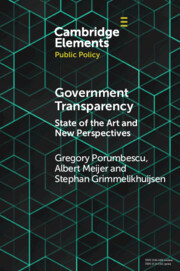Element contents
Government Transparency
Published online by Cambridge University Press: 15 June 2022
Summary
Keywords
- Type
- Element
- Information
- Series: Elements in Public PolicyOnline ISBN: 9781108678568Publisher: Cambridge University PressPrint publication: 07 July 2022
References
- 27
- Cited by

